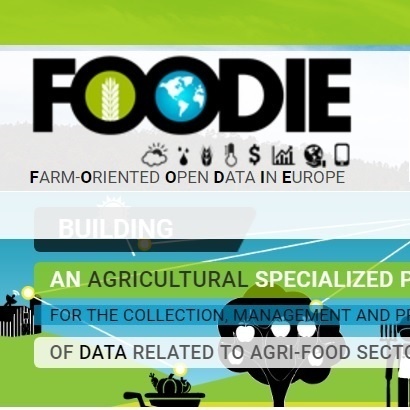FOODIE Data Models : rationale for Community for On-Farm Data Sharing


While taking varying approaches to modeling space and geography, different organisations are presenting a geospatial interoperability challenge of different formats, divergent coordinate systems, and varying collection or aggregation units. The FOODIE project aims at building an open and interoperable agricultural specialized hub on the cloud for the management of spatial and non-spatial data relevant for farming production.
IT'S ALL ABOUT INTEROPERABILITY: There’s a growing interest in data-driven digital agriculture and, consequently, in integrating a range of farmer data (particularly soils, climate) with other datasets (e.g. with govermental data: DATA.GOV). The main goal is to develop some innovative processes/analytics and products that will be valued/used by the farming community. |
Agricultural innovation requires a degree of concerted action in a network of interdependent actors (with roles suiting the particular expertise), based on mutual expectations and agreement on how to move forward.
In general though, they take varying approaches to modeling space and geography, presenting a geospatial interoperability challenge of different data formats (most of which are proprietary), divergent coordinate systems, and varying collection or aggregation units.
In some cases these are complementary and in other cases overlapping. Accordingly, there is a need of a standard and unified agricultural feature model capable to include all the nuances of the underlying data models and which could be incorporated into various agricultural data specifications and provide a form of consistency and validity to the representation of space +/- time.
In this regard, FOODIE (FARM-ORIENTED OPEN DATA IN EUROPE) project is creating a platform hub on the cloud where spatial/temporal and non-spatial data (thematic) [as well as meta-information] related to agricultural sector are available for agri-food stakeholders groups and interoperable.
Conceptual model of FOODIE relies upon the following basic pillars:
|
FOODIE follows a brokering approach for data discovery and access, which allows to account for a diversity of data models and to translate available information in the desired data model(s), in particular, the FOODIE data model.
FOODIE data model specification ensures:
|
Regarding the initial import of data, it is possible to re-use the data already contained in an LPIS. In that sense INSPIRE data model and LPIS concepts are complementary approaches for FOODIE.
Three application schemas have been developed in order to support the complex modelling of the (precision) agriculture applications:
|
Sources:
________________________________________________________________________________________________________
Related content:
- FOODIE presentations (papers, posters, brochures ...)
- Concept of Collaborative and Open Innovation Approaches for Development of Agriculture Data Hub in Africa
- Seamless Open Land-Use Map of EuropeAgX platform - a Platform as a Service (PaaS) for the agricultural industry that provides the necessary geospatial infrastructure for a community of integrated precision agricultural products and services, - can be seen as an operational pseudo-standard which may provide some insights into the need for such ‘common ag features’
- AGQ Labs adopts Open Modus Standard for Soil Ag Data
- Toward Geopolitical-Context-Enabled Interoperability in Precision Agriculture: AgGateway's SPADE, PAIL, WAVE, CART and ADAPT [AgGateway identified interoperability in field operations (e.g., planting, harvest) as a major challenge]
- 2017 EFITA CONGRESS (02 July 2017 - 06 July 2017)

